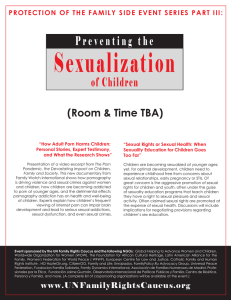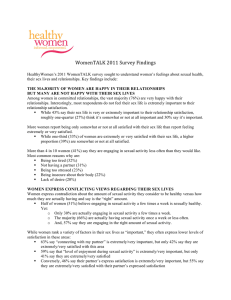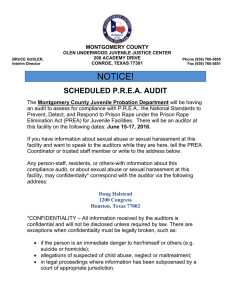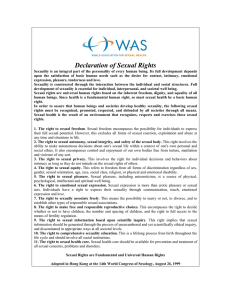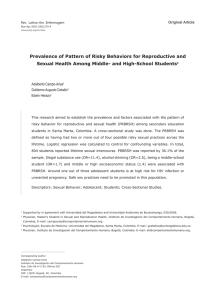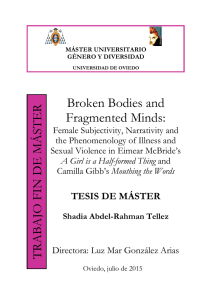Sexual behavior in Spanish adolescents of divorced
Anuncio
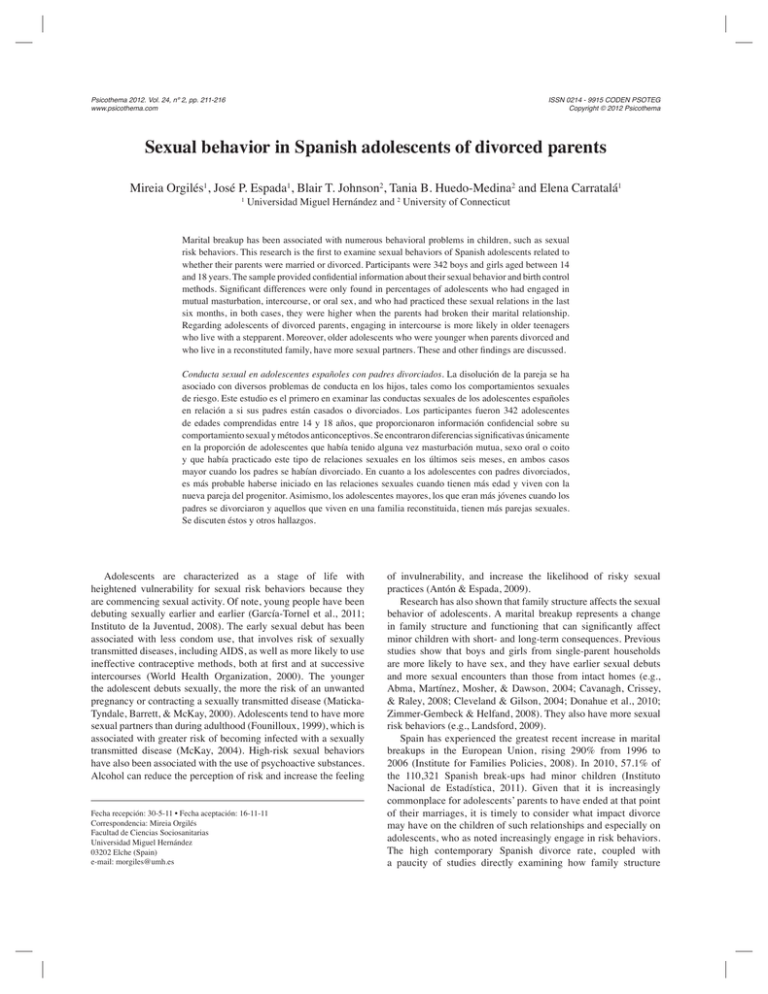
Psicothema 2012. Vol. 24, nº 2, pp. 211-216 www.psicothema.com ISSN 0214 - 9915 CODEN PSOTEG Copyright © 2012 Psicothema Sexual behavior in Spanish adolescents of divorced parents Mireia Orgilés1, José P. Espada1, Blair T. Johnson2, Tania B. Huedo-Medina2 and Elena Carratalá1 1 Universidad Miguel Hernández and 2 University of Connecticut Marital breakup has been associated with numerous behavioral problems in children, such as sexual risk behaviors. This research is the first to examine sexual behaviors of Spanish adolescents related to whether their parents were married or divorced. Participants were 342 boys and girls aged between 14 and 18 years. The sample provided confidential information about their sexual behavior and birth control methods. Significant differences were only found in percentages of adolescents who had engaged in mutual masturbation, intercourse, or oral sex, and who had practiced these sexual relations in the last six months, in both cases, they were higher when the parents had broken their marital relationship. Regarding adolescents of divorced parents, engaging in intercourse is more likely in older teenagers who live with a stepparent. Moreover, older adolescents who were younger when parents divorced and who live in a reconstituted family, have more sexual partners. These and other findings are discussed. Conducta sexual en adolescentes españoles con padres divorciados. La disolución de la pareja se ha asociado con diversos problemas de conducta en los hijos, tales como los comportamientos sexuales de riesgo. Este estudio es el primero en examinar las conductas sexuales de los adolescentes españoles en relación a si sus padres están casados o divorciados. Los participantes fueron 342 adolescentes de edades comprendidas entre 14 y 18 años, que proporcionaron información confidencial sobre su comportamiento sexual y métodos anticonceptivos. Se encontraron diferencias significativas únicamente en la proporción de adolescentes que había tenido alguna vez masturbación mutua, sexo oral o coito y que había practicado este tipo de relaciones sexuales en los últimos seis meses, en ambos casos mayor cuando los padres se habían divorciado. En cuanto a los adolescentes con padres divorciados, es más probable haberse iniciado en las relaciones sexuales cuando tienen más edad y viven con la nueva pareja del progenitor. Asimismo, los adolescentes mayores, los que eran más jóvenes cuando los padres se divorciaron y aquellos que viven en una familia reconstituida, tienen más parejas sexuales. Se discuten éstos y otros hallazgos. Adolescents are characterized as a stage of life with heightened vulnerability for sexual risk behaviors because they are commencing sexual activity. Of note, young people have been debuting sexually earlier and earlier (García-Tornel et al., 2011; Instituto de la Juventud, 2008). The early sexual debut has been associated with less condom use, that involves risk of sexually transmitted diseases, including AIDS, as well as more likely to use ineffective contraceptive methods, both at first and at successive intercourses (World Health Organization, 2000). The younger the adolescent debuts sexually, the more the risk of an unwanted pregnancy or contracting a sexually transmitted disease (MatickaTyndale, Barrett, & McKay, 2000). Adolescents tend to have more sexual partners than during adulthood (Founilloux, 1999), which is associated with greater risk of becoming infected with a sexually transmitted disease (McKay, 2004). High-risk sexual behaviors have also been associated with the use of psychoactive substances. Alcohol can reduce the perception of risk and increase the feeling Fecha recepción: 30-5-11 • Fecha aceptación: 16-11-11 Correspondencia: Mireia Orgilés Facultad de Ciencias Sociosanitarias Universidad Miguel Hernández 03202 Elche (Spain) e-mail: [email protected] of invulnerability, and increase the likelihood of risky sexual practices (Antón & Espada, 2009). Research has also shown that family structure affects the sexual behavior of adolescents. A marital breakup represents a change in family structure and functioning that can significantly affect minor children with short- and long-term consequences. Previous studies show that boys and girls from single-parent households are more likely to have sex, and they have earlier sexual debuts and more sexual encounters than those from intact homes (e.g., Abma, Martínez, Mosher, & Dawson, 2004; Cavanagh, Crissey, & Raley, 2008; Cleveland & Gilson, 2004; Donahue et al., 2010; Zimmer-Gembeck & Helfand, 2008). They also have more sexual risk behaviors (e.g., Landsford, 2009). Spain has experienced the greatest recent increase in marital breakups in the European Union, rising 290% from 1996 to 2006 (Institute for Families Policies, 2008). In 2010, 57.1% of the 110,321 Spanish break-ups had minor children (Instituto Nacional de Estadística, 2011). Given that it is increasingly commonplace for adolescents’ parents to have ended at that point of their marriages, it is timely to consider what impact divorce may have on the children of such relationships and especially on adolescents, who as noted increasingly engage in risk behaviors. The high contemporary Spanish divorce rate, coupled with a paucity of studies directly examining how family structure 212 MIREIA ORGILÉS, JOSÉ P. ESPADA, BLAIR T. JOHNSON, TANIA B. HUEDO-MEDINA AND ELENA CARRATALÁ relates to children’s sexual behavior makes an investigation of these issues quite timely. Until now no study examined the role of parental divorce in the sexual activity of their adolescent children. The current study, thus examines this phenomenon, including risk practices (e.g., intercourse without a condom) and evaluate how these behaviors may relate to parental divorce (e.g. time elapsed since the divorce of the parents, perceived quality of the relationship between parents, living with a stepfather or stepmother). Based on recent previous research with samples from other countries (e.g. Donahue et al., 2010; Zimmer-Gembeck & Helfand, 2008), we specifically examine whether Spanish adolescents whose parents have broken their marital relationship will be more likely to have sexual relations, more frequent sexual activity, an early sexual debut, and more risk sexual behaviors (less condom use, sex along with drugs) than adolescents living with both parents. In addition, we assess whether adolescents with divorced parents will be more likely to undertake risk sexual behaviors when these divorces occurred more recently and when they live with a stepparent. Method Participants Participants in the study were 342 adolescents with 50% whose parents were divorced and a matched sample of 50% whose parents were married. The divorced sample was matched to the non-divorced sample by selecting at random adolescents who matched for age, gender, socioeconomic status, and geographic location from the total sample (n= 1045). Mean age was 15.85 years (SD= 0.76; range: 14 to 18); 136 were boys (39.8%) and 206 girls (60.2%). No significant differences (p= .93) were found in the mean age between girls (M= 15.81; SD= .74) and boys (N= 15.92; SD= .80). For the subsamples of adolescents with divorced and married parents mean age were 15.91 (SD= 0.77) and 15.80 (SD= 0.76), respectively. The discrepancy between the percentage of girls and boys is due to the skew distribution on gender that exists in the Spanish schools because the dropout, more likely in boys than in girls. Most participants were heterosexual (97.4%), with few homosexual (1.8%) or bisexual (0.9%). To recruit the sample, 15 selected schools were contacted based on their availability, three in the North, three in the South, two in the East, four in the Southeast, and three in Central. Nine were selected along the coast and the other six in the interior. We included schools located in rural and urban areas. Appropriate permissions were applied to principals of schools and parents. The adolescents whose parents gave written informed consent (99% of the total possible, N= 1,216) were included in the sample prior to the matching procedure. In these samples, 20% of the parents were divorced, with the percentage ranging between 16% (in the East) and 26% (North), figures that roughly match national divorce rate trends. Procedure Participants (N= 1,216) completed questionnaires collectively in classrooms, in groups of approximately 20 students. The written instructions were also read aloud, and questions were answered. The questionnaires were anonymous and their order counterbalanced so that each student received the tests in a different order to the students who sat around. To reassure the privacy of the replies, an envelope was provided to each adolescent to put the questionnaire after completing it. Instruments Information concerning demographic variables (age, gender, school, city of residence, country of birth, socioeconomic status) and variables related to the family situation of each adolescent was collected with questionnaires. Sexual behavior assessment followed convention (e.g., Aspy et al., 2007; Bersamin et al., 2008; Jónsson, Njardvik, Ólafsdóttir, & Grétarsson, 2000). Questions addressed (a) sexual activity (Have you ever had mutual masturbation, intercourse or oral sex? Have you had mutual masturbation, intercourse or oral sex in the last 6 months:?); (b) age at sexual debut (How old were you the first time you had intercourse?); (c) type of sexual relations (What type of sexual relations have you had in the last 6 months?); (d) number of couples (How many sexual partners have you had in the last 6 months?), and (e) frequency of sexual practice (How often have you had mutual masturbation, intercourse or oral sex in the last 6 months?). Three questions sought information on the prevention methods used when intercourse took place (Did you use a condom the first time you had intercourse? When you have intercourse, which prevention method do you use? What percentage of times do you use a condom when you have sex?). It asked whether sex took place under the influence of drugs (Have you ever had sex under drugs effects?). Data analysis Differences between adolescents with divorced parents versus those with married parents were examined using a chi-square for a comparison between two independent samples. Effect size indexes are valuable to demonstrate on a common metric how much adolescents whose parents are divorced exhibit sexual behavior that differs from adolescents whose parents are married. When risk was higher for adolescents with divorced parents, the odds ratio (OR) was calculated such that values larger than 1 or the standardized mean difference (d) are positive; when risk was higher for adolescents with married parents, the OR is less than 1 and d is less than 0. A multiple regression analysis was carried out to examine factors related to sexual debut and number of sexual partners. Results Description of adolescents whose parents divorced The average age of adolescents at the time of their parents’ divorce was 7.81 years (SD= 4.22; range: 0 to 17 years). The 87% of adolescents lived with their mother and the 6% with their father; custody was shared in 5% of cases; the remaining 2% lived with grandparents. In addition, 15% lived with their mother or father and with a stepparent, and 44% had siblings living at home. The quality of the relationship between parents after divorce was perceived as good for the 72%, with no apparent conflicts. Much smaller percentages (9%) perceived it as conflicting or (19%) claimed that there was no contact between their parents. 213 SEXUAL BEHAVIOR IN SPANISH ADOLESCENTS OF DIVORCED PARENTS Sexual behaviors Table 1 shows how the sexual behavior of adolescents with divorced parents compares with their counterparts whose parents are not divorced. As Table 1 shows, across the sexual behaviors, effect sizes tended to be small to very small. The only statistically significant differences that appeared were on the percentages of adolescents who had ever had mutual masturbation, intercourse or oral sex and had practiced these sexual relations in the last 6 months. In both cases, adolescents with divorced parents showed larger percentage than those with married parents. Thus, adolescents with married parents are nearly half as likely to have had sexual relations than those with divorced parents and to be sexually active recently (ORs= 1.94 and 1.79, respectively). An examination of the other sexual behaviors suggests that these two groups are more similar than different. Analysis of sexual behavior in adolescents whose parents divorced No significant differences were found according to gender at the age of sexual debut (p = .16), number of sexual partners (p= .53), percentage of condom use (p= .11), having ever had sex (p= .80), having had sex in the last six months (p= .32), type of sexual relations (p= .94), prevention method (p= .11), use of condom at first intercourse (p= .19), and having sex along with drugs (p= 10). A multiple regression analysis examined factors related to sexual debut and number of partners in adolescents whose parents divorced (age, living with a stepparent, having siblings, age of adolescents when parents divorced, conflict between parents perceived by children). Variables in which significant differences were found are presented in Table 2. As the table shows, adolescents who had intercourse were older and lived with a stepfather or stepmother more often than those who have never had sex. Adolescents with more partners were older, lived with stepparents, and were younger when their parents divorced. Discussion The current study is the first to evaluate the impact of parents’ divorce on the sexual behavior of Spanish adolescents. As expected, the percentage of adolescents that ever practiced mutual masturbation, intercourse or oral sex is higher than the percentage of those living with both parents, as well as the percentage that had these sexual relations in the last six months. The results agree Table 1 Sexual behaviour of adolescents as a function of parental marital status Parents divorced Mutual masturbation, intercourse or oral sex Mutual masturbation, intercourse or oral sex in the last 6 months Frequency of mutual masturbation, intercourse or oral sex in the last 6 months Type of sexual relations Prevention method Condom at first intercourse Sex along with drugs Parents married % χ2 OR 071 41.5 9.17** 1.94 100 58.5 6.94** 1.79 1.13 1.34 n % n Yes 99 57.9 No 72 42.1 Yes 83 48.5 059 34.5 No 88 51.5 112 65.5 Once a month 21 25.3 013 22.0 2 or 3 times a month 25 30.1 017 28.8 1 or 2 times a week 20 24.1 015 20.0 3 or more times a week 14 16.9 013 22.0 Amost every day 03 3.6 001 03.0 Mutual masturbationa 09 10.84 004 06.78 Vaginal 36 43.37 023 38.98 0.50 Oral sex 08 9.64 005 08.47 0.71 Anal sex 01 1.20 001 01.69 0.44 All 29 34.94 026 44.07 0.50 Condom 17 20.5 008 13.6 Other 66 79.5 051 86.4 Yes 75 90.4 051 86.4 No 08 9.6 008 13.6 Always 35 54.7 023 45.1 Yes 39 47 027 48.2 No 44 53 029 51.8 M SD M SD 1.68 1.14 0.61 0.53 0.68 0.020 0.98 t d Age at first intercourse 14.97 00.75 14.96 01.01 -0.090 -0.011 Number of sexual partners 01.55 00.87 01.69 01.30 -0.770 -0.130 Percentage of condom use 88.64 18.17 87.65 18.61 -0.29 -0.054 a Note: Category of comparison, OR= odds ratio, %= percentage per columns, Yes coded as 0, No coded as 1, and prevention method, other coded as 0, condom coded as 1. * p<.05; ** p<.01; *** p<.001 214 MIREIA ORGILÉS, JOSÉ P. ESPADA, BLAIR T. JOHNSON, TANIA B. HUEDO-MEDINA AND ELENA CARRATALÁ with those obtained in previous studies linking single parents with sexual activity of children. Previous research have shown that living with only one parent increases the probability of having debuted sexually (Donahue et al., 2010), a probability that can be 2 to 2.5 times higher among adolescents aged 12 to 15 who come from non-intact families than in those with traditional families (Flewelling & Baumann, 1990). The increased sexual activity of adolescents with divorced parents found in our study might be explained, as previous research, by the more acceptance of their children’s sexual relations that sometimes characterize divorced parents (e.g., Davis & Friel, 2001). Several authors have indicated that a family with just one parent has been closely associated with an early sexual episode (Best, 2000; D’Onofrio et al., 2006; Laflin, Wang, & Barry, 2008; Zimmer-Gembeck & Helfand, 2008). Despite the evidence found in previous research on the initiation of sexual intercourse at an earlier age among children of divorced parents, no significant difference emerged in this study: It was an average of 15-years old in both groups. Results in Spanish general population reported an age of sexual initiation ranging from 15 to 18 years (García-Tornel et al., 2011; Gómez, Sola, Cortés, & Mira, 2007; Instituto de la Juventud, 2008). In a recent study carried out, the age at first intercourse at a Spanish sample of adolescents between 13 to 18 years old was 15.25 years (García-Vega, Menéndez, García, & Rico, 2010), an average age similar to the age of sexual debut found in the current study in both groups of adolescents. Teva, Bermúdez, & BuelaCasal (2009), among Spanish adolescents aged from 13 to 18 years, reported a mean age at the onset of sexual intercourse of 14.8 in males and 15 in females, founding no significant differences by gender according to the results of our study. The outcomes indicate that family structure seems influence neither the frequency of sex nor the type of sexual relations they maintain. Vaginal intercourse is the type of sex practiced more often by both adolescents with divorced and non-divorced parents. Regarding high-risk sexual behavior, no significant difference appeared between adolescents with divorced and non-divorced parents in the use of condoms, or in the practice of sex under the influence of drugs. In fact, contrary to expected, the percentage of adolescents who used a condom at first intercourse and use it in all the following intercourses is higher, though not significantly different, in those whose parents are divorced. Moreover, although these differences also are not significant, the percentage of participants who had sex along with drugs (alcohol, cannabis, cocaine, synthetic drugs or hallucinogens) is slightly higher when living with both parents, contrary to previous results reporting a higher probability of consuming alcohol, tobacco, and drugs in children with divorced parents in comparison to those in intact families (e.g., Mak et al., 2010). Regarding the sexual behavior of adolescents with divorced parents, the current study found that those who sexually debuted are older than those who have not debuted, parallel with previous studies carried out with Spanish general population (Lameiras, Rodríguez, Calado, & González, 2004). The current research also found that adolescents were more likely to debut and to have more sexual partners if they lived in a reconstituted family with a stepparent, similar to other studies (Flewelling & Baumann, 1990; Upchurch, Aneshensel, Sucoff, & Levy-Storms, 1999). The age of adolescents when parents divorced also seems to be related to the number of sexual partners, such that those adolescents who were younger at time of the marital breakup have more partners. Possibly, children who were younger when their parents divorced have witnessed one or both parents being romantic with more potential mates and model their own behavior (Whitbeck, Simons, & Kao, 1994), maybe with a more liberal and positive attitude towards practicing sexual relations with more partners. Finally, although past studies found that the level of conflict during the marital breakup was linked to sexual activity of children (e.g., Repetti, Taylor, & Seeman, 2002), the current study did not replicate this finding. Also not confirmed in the current study is the finding from some studies that having siblings is related to sexual debut (Haurin & Mott, 1990). It is unclear why these patterns differ across studies. In sum, the current study reached several important conclusions. Adolescent children of divorced parents generally have sexual experiences very similar to those whose parents are still married. The age of first intercourse, number of sexual partners, frequency of sex, type of sexual activity, and sexual risk behaviors do not depend on parental marital status. Yet, adolescents whose parents were divorced were more likely to engage in some types of recent sexual behavior (mutual masturbation, intercourse, or oral sex) than those whose parents were still married. Regarding adolescents Table 2 Relation among sexual behaviors as a function of family structure among adolescents whose parents were divorced Dependent variable Sexual debut Independent variable Age Value OR 95% CI 14 0.51 (0.32, 0.80) 3.86 (1.33, 11.20) 18 Stepparents Yes No Estimate Age Number of sexual partners Age when parents divorced Stepparents β 14 0.45 (0, 0.90) 18 3.72 (2.34, 5.10) 0 0.80 (0, 1.60) 17 3.051 (2.066, 4.035) Yes 2.016 (1.47, 2.56) No 1.36 (0.83, 1.88) 0.27* -0.24* -0.25* SEXUAL BEHAVIOR IN SPANISH ADOLESCENTS OF DIVORCED PARENTS with divorced parents, those who had intercourse are older and live with a stepfather or stepmother. Having more sexual partners is more likely for older adolescents, who were younger when parents divorced, and live in a reconstituted family. The study has several strengths and limitations. This is the first research in Spain that assesses sexual risk behaviors in adolescents with divorced parents. Divorce in Spain is a relatively recent phenomenon and there is a lack of studies on the children’s adaptation to the changes in their families. Providing information 215 in this field can improve the quality of life in this population and focus prevention on the specific risk factors. However, since there are no Spanish population studies examining the sexual behaviors of adolescents with divorced and non-divorced parents, it is not possible to compare the present results with previous findings. Furthermore, it would be useful in future studies to analyze different variables that have not been included in this research, as the religious beliefs, the parenting style, or information that teenagers have about sexuality. References Abma, J.C., Martínez, G.M., Mosher, W.D., & Dawson, B.S. (2004). Teenagers in the United States: Sexual Activity, Contraceptive Use, and Childbearing, 2002. National Center for Health Statistics. Vital and Health Statistics, 24, December 2004. Antón, F.A., & Espada, J.P. (2009). Consumo de sustancias y conductas sexuales de riesgo para la transmisión del VIH en una muestra de estudiantes universitarios. Anales de Psicología, 25, 344-350. Aspy, C.B., Vesely, S.K., Oman, R.F., Rodine, S., Marshall, L., & McLeroy, K. (2007). Parental communication and youth sexual behavior. Journal of Adolescence, 30, 449-466. Bersamin, M., Todd, M., Fisher, D.A., Hill, D.L., Grube, J.W., & Walker, S. (2008). Parenting practices and adolescent sexual behavior: A longitudinal study. Journal of Marriage and Family, 70, 97-112. Best, K. (2000). Many youth face grim STD risks. Network, 20, 14-20. Cavanagh, S.E., Crissey, S.R., & Raley, R.K. (2008). Family structure history and adolescent romance. Journal of Marriage and Family, 70, 698-714. Centro Nacional de Epidemiología. Instituto de Salud Carlos III (2008). Vigilancia epidemiológica del sida en España. Registro Nacional de Casos de Sida. Informe semestral nº 1, año 2008. Retrieved from http://www.isciii.es/htdocs/centros/epidemiologia/pdf/SPNS_Informe_ semestral.pdf. Chilman, C.S. (1986). Some psychosocial aspects of adolescent sexual and contraceptive behaviors in a changing American society. In J.B. Lancaster & B.A. Hamburg (Eds.), School-age pregnancy and parenthood: Biosocial dimensions (pp. 191-217). New York: Aldine de Gruyter. Cleveland, H.H., & Gilson, M. (2004). The increased importance of motherchild relationships on sexual behaviors of adolescents in disadvantaged neighbourhoods. Journal of Youth and Adolescence, 33, 319-329. Davis, C.E., & Friel, L. (2001). Adolescent sexuality: Disentangling the effects of family structure and family context. Journal of Marriage and the Family, 63(3), 669-681. Donahue, K.L., D’Onofrio, B.M., Bates, J.E., Lansford, J.E., Dodge, K.A., & Pettit, G.S. (2010). Early exposure to parents’ relationship instability: Implications for sexual behaviour and depression in adolescence. Journal of Adolescent Health, 47, 547-554. D’Onofrio, B.M., Turkheimer, E.N., Emery, R.E., Slutske, W., Heath, A., Madden, P.A.F., & Martin, N.G. (2006). A genetically informed study of the processes underlying the association between parental marital instability and offspring adjustment. Developmental Psychology, 42, 486-499. Flewelling, R., & Bauman, K. (1990). Family structure as a predictor of initial substance use and sexual intercourse in early adolescence. Journal of Marriage and the Family, 52, 171-181. Founilloux, W. (1999). Prevention at school: An arduous course, UNESCO Courier, October, 30-31. García-Vega, E., Menéndez, E., García, P., & Rico, R. (2010). Influencia del sexo y género en el comportamiento sexual de una población adolescente. Psicothema, 22(4), 606-612. García-Tornel, S., Miret, P., Cabré, A, Flaquer, L., Berg-Kelly, K., Roca, G., & Lailla, J.M. (2011). El adolescente y su entorno en el siglo XXI. Instantánea de una década. Esplugues de Llobregat: Hospital Sant Joan de Déu. Gómez, M. A., Sola, A., Cortés, M. J., & Mira, J. J. (2007). Sexual behavior and contraception in people under the age of 20 in Alicante, Spain. The European Journal of Contraception and Reproductive Health Care, 12(2), 125-130. Haurin, R.J., & Mott, F.L. (1990). Adolescent sexuality activity in the family context: The impact of older siblings. Demography, 27, 537-557. Institute for Families Policies (2008). Report of the evolution of the family in Europe. Retrieved from http://www.ipfe.org/Informe_Evolucion_ Familia_Europa_2008_def_esp.pdf. Instituto de la Juventud (2008). Informe Juventud en España. Madrid: INJUVE. Instituto Nacional de Estadística (2010). Estadísticas de nulidades, divorcios y separaciones. Retrieved from http: // www.ine.es. Jónsson, F., Njardvik, U., Ólafsdóttir, G., & Grétarsson, S.J. (2000). Parental divorce: Long-term effects on mental health, family relations and adult sexual behavior. Scandinavian Journal of Psychology, 41, 101-105. Laflin, M.T., Wang, J., & Barry, M. (2008). A longitudinal study of adolescent transition from virgin to nonvirgin status. Journal of Adolescent Health, 42(3), 228-236. Lameiras, M., Rodríguez, Y., Calado, M., & González, M. (2004). Determinantes del inicio de las relaciones sexuales en adolescentes españoles. Cuadernos de Medicina Psicosomática y Psiquiatría de Enlace, 71, 67-75. Lansford, J.E. (2009). Parental divorce and children’s adjustment. Perspectives on Psychological Science, 4, 140-152. Maccoby, E.E. (1998). The two sexes: Growing up apart, coming together. In Family and public policy. Cambridge: Belknap Press/Harvard University Press. Mak, K., Ho, S., Thomas, G.N., Schooling, C.M., McGhee, S.M., & Lam, T.H. (2010). Family structure, parent-child conversation time and substance use among Chinese adolescents. BMC Public Health, 10, 503. McLanahan, S., & Sandefur, G.D. (1994). Growing up with a single parent: What hurts, what helps. Cambridge, Mass.: Harvard University Press. Maticka-Tyndale, E., Barrett, M., & McKay, A. (2000). Adolescent sexual and reproductive health in Canada: A review of national data sources and their limitations. The Canadian Journal of Human Sexuality, 9, 41-65. McKay, A. (2004). Adolescent sexual and reproductive health in Canada: A report card in 2004. The Canadian Journal of Human Sexuality, 13(2), 67-81. Repetti, R., Taylor, S., & Seeman, T. (2002). Risky families: Family social environments and the mental and physical health of offspring. Psychological Bulletin, 128, 330-366. Resnick, M.D., Bearman, P.S., Blum, R.W., Bauman, K.E., Harris, K.M., Jones, J., & Udry, R. (1997). Protecting Adolescents from Harm: Findings from the National Longitudinal Study on Adolescent Health. JAMA, 278(10), 823-832. Teva, I., Bermúdez, M.P., & Buela-Casal, G. (2009). Characteristics of sexual behavior in Spanish adolescents. The Spanish Journal of Psychology, 12, 471-484. Thompson, E., McLanahan, S.S., & Curtin, R.B. (1992). Family structure, gender and parental socialization. Journal of Marriage and the Family, 54, 368-378. 216 MIREIA ORGILÉS, JOSÉ P. ESPADA, BLAIR T. JOHNSON, TANIA B. HUEDO-MEDINA AND ELENA CARRATALÁ UNAIDS / WHO (2008). Informe sobre la epidemia mundial de Sida. Retrieved from http://www.unaids.org. Upchurch, D.M., Aneshensel, C.S., Sucoff, C.A., & Levy-Storms, L. (1999). Neighborhood and family contexts of adolescent sexual activity. Journal of Marriage and the Family, 61, 920-933. Whitbeck, L.G., Simons, R.L., & Kao, M.Y. (1994). The effects of divorced mothers’dating behaviors and sexual attitudes on the sexual attitudes and behaviors of their adolescent children. Journal of Marriage and the Family, 56, 615-621. World Health Organization (2000). The context of young people’s sexual relations. Progress in Reproductive Health Research, 53, 2-4. Zimmer-Gembeck, M.J., & Helfand, M. (2008). Ten years of longitudinal research on U.S. adolescent sexual behaviour: Developmental correlates of sexual intercourse and the importance of age, gender and ethnic background. Developmental Review, 28(2), 153-224.
